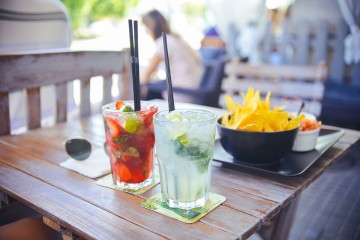When used to refer to any generic alcoholic mixed drink, cocktail may mean any beverage that contains three or more ingredients if at least one of them contains alcohol. When a mixed drink contains only a distilled spirit and a mixer, such as soda or fruit juice, it is a highball; many of the International Bartenders Association Official Cocktails are highballs.
When a cocktail contains only a distilled spirit and a liqueur, it is a duo and when it adds a mixer, it is a trio. Additional ingredients may be sugar, honey, milk, cream, and various herbs.
The modifying agent is the ingredient that gives the cocktail its character. Its function is to soften the raw alcohol taste of the base, while at the same time to enhance its natural flavor. Typical modifying agents are aromatic wines (such as vermouth) and spirits (such as Fernet Branca or Amer Picon), bitters, fruit juices and “smoothing agents” such as sugar, eggs, and cream.
The base is the principal ingredient of the cocktail. It is typically a single spirit such as rum, gin, or whiskey, and typically makes up 75 percent or more of the total volume of the cocktail before icing.
Special flavoring and coloring agents include liqueurs (such as Grand Marnier or Chartreuse), Cordials, Bitters like Angostura Bitters,etc. and non-alcoholic flavored syrups (such as Grenadine or Orgeat syrup). These are typically used in place of simple syrup, and are to be used sparingly. Cocktails of the Aromatic Type use as modifying agents bitters or aromatic wines or spirits.
Cocktails of the Sour Type use as modifying agents a fruit juice (typically, lemon or lime) and sugar. For these a ratio of 1 part sweet to 2 parts sour to 8 parts base is generally recommended. However, Embury makes it very clear that he thinks the idea that a drink must be made according to one exact recipe preposterous, and that the final arbiter is always your taste. He suggests trying different ratios, finding the one that is most pleasing to you, and sticking with it.



